
12/22/6 - 12/31/6
christopher funderburg
In October 2006, Funderburg and Cribbs set out to watch at least 200 movies over the course of the next 200 days. They both watched a different slate of films and wrote about every single one; from epic high art masterpieces such as all ten parts of Kieslowski's Decalogue to instantly forgettable Hollywood crap du jour like A Perfect Stranger to cult classics like Sam Fuller's White Dog. In sections spanning 10 days at a time, The Pink Smoke is reprinting their writings about the grueling experiment in cinematic endurance.
<<click here for 12/12/6 - 12/21/6>>
12.22.6. Ashes and Diamonds.
(dvd) train to Edmonton.
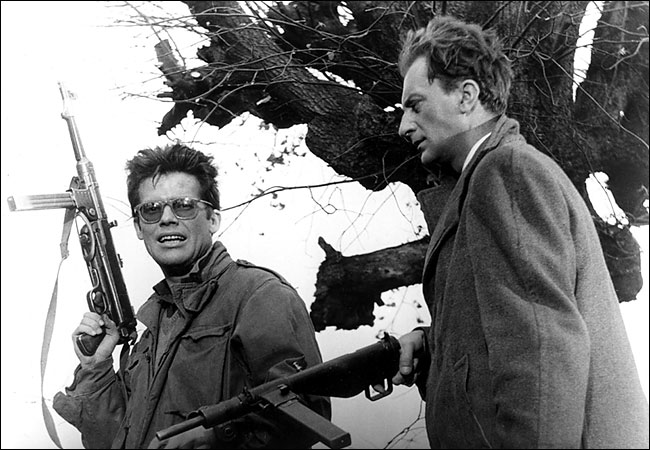
Not at all what I was expecting. I think I was imagining something dour and solemn, the type of war film belonging to the "tradition of quality" that normally gets canonized. But this movie is awesome. The opening scene of a botched hit on a Russian labor leader is great and the main duo of jaded old-school resistance fighter and young hedonistic hotshot is as timeless and enjoyable as Jean Gabin and René Dary in Touchez Pas Au Grisbi (or Murtaugh and Riggs in Lethal Weapon). Despite being made in 1958, this film feels ultra-modern. It reminded me of Jean-Pierre Melville's forward-thinking gangster films, but also every revisionist war film since 1980 that thought it was breaking new ground by showing how war is hell and heroes are flawed. The Jacob Burns Film Center (where I work) was given a copy of the "Janus 50th Anniversary" box-set (courtesy of the lovely Sarah Finklea) and, in anticipation of my interminable trip to Calgary, I grabbed a bunch of films from it that I hadn't seen. It's a great box set because it's full of things that you haven't seen, but probably should've - like the aforementioned Colonel Blimp and Andrzej Wajda's super-fantastique Ashes and Diamonds.
I suppose I've unintentionally been on a bit of a war and resistance kick with Army of Shadows, Blimp, and now Ashes and Diamonds. The muted nihilism of these films is a good match for my current brain-state and the way in which the characters handle their situations is interestingly varied amongst the three films. Shadows features heroes of the intellectual cool variety, the main character is a chubby bespectacled gentleman who refuses to break under duress ("he won't run, dammit!"), a man who is unhesitatingly brutal when that's what the situation calls for in spite of his unassuming demeanor. Blimp's Wynne-Candy is a doddering charmer who doesn't realize the world is passing him by and fails to understand that his way of life is under siege until it's too late. Ashes and Diamonds' army-jacketed, shades-sporting hothead has a sense of style that wouldn't put him out of place in Williamsburg and he's at least concerned with nailing the bartender as offing the Russian politico - he's going to go down on his terms, swilling vodka, guns blazing. History catches up with these anti-heroes in one way or another, but the thread of "born with scream/die with a whimper/in between you must/ lose your temper" runs forcefully throughout all three films. And also, remember how I said Army of Shadows might be in the running for greatest film of all time? Put Ashes and Diamonds down on that list, too.
12.23.06. Haxan.
(dvd) first 3 parts on the train to Edmonton, the rest while waiting at the Edmonton train station for my parents to pick me up.
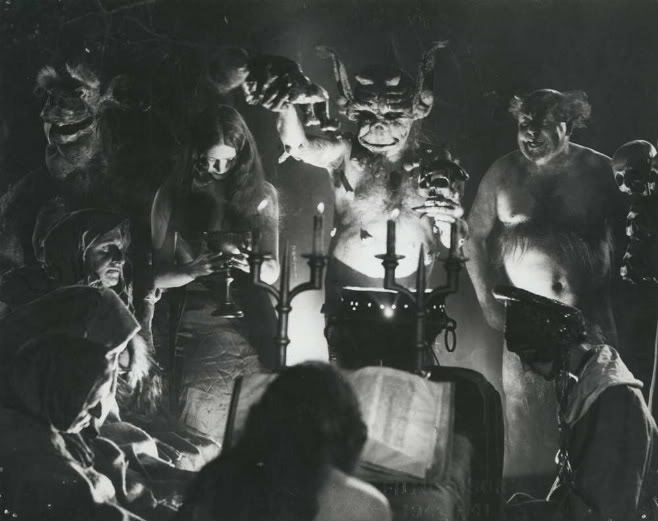
Haxan is the original pseudo-documentary cinematic oddity. Its long lineage extends through every film that ever compiled a near-random assortment of weirdness of dubious factual value and then spiced it up with re-creations, elliptical philosophy, and narrative dead-ends. A cult favorite, this study of witches and warlocks consists of seven unequal parts, ranging from a fascinating chapter on the history of visual depictions of Satanism, witch-craft, and hell to broadly comedic interludes about shrewish hags brewing up eyeball stew seasoned with the fleshy parts of wayward youngsters.
Made in 1922, I'm not sure if silent film audiences responded to this film as the factually informative exploration of the centuries old-traditions of witchcraft that it presents itself as being or if its frequent ridiculousness was as obvious then as it is now - but what the hell, in this day and age, people on the internet are still concerned The Poughkeepsie Tapes are real. I've often heard Haxan referred to as an interesting social document of its time, but nothing about it strikes me as particularly illuminating about 1922 (not in any way that any other film from 1922 isn't comparably illuminating). Anyway, this film is enjoyable by the sheer force of its lurid, "throw everything against the wall and see what sticks" approach, but there's not a whole lot going on outside of the creepy cardboard cut-outs of demons pumping bellows full of sulfur down the throats of hell's captives or instructions for preparing babies for sacrifice in demonic ceremonies. Did I mention there's a very unfunny skit about a witch snatching up kiddies?
12.24.06. Night at the Museum.
(I-Max) Paramount Famous Players in Calgary.
Did you know that I-Max is a Canadian invention? Neither did I until the five minute intro before the film gave me a brief history of the technology and a demonstration of its capacities. According to the intro, I-Max is "the pride of Canada," but there were a lot of things in Alberta that were "the pride of Canada" (including the Edmonton Oilers, the Canadian Rockies, Molson beer, and some pop star named Eva) - I guess there's just a lot of pride to go around up there. I was just disappointed Rick Moranis didn't get a single name-check the entire time I was there. Rick Moranis rules and should be the pride of Canada, if he isn't.
Anyway, Night at the Museum with Ben Stiller is exactly what it appears to be from the previews, one of those high concept family comedies overstuffed with special effects and featuring more star cameos than jokes. I used to really like Ben Stiller. Maybe I still do. Anyway, I started to back away from the bandwagon when Cribbsy and I actually went back and watched some episodes of the famous "Ben Stiller Show" after it first came out on dvd. Ouch. It didn't age so well unless you're really into jokes about generation-X pop cultural touchstones, Martin Scorsese's Cape Fear, and how Fox is a second-rate network. It actually really sucked, even with Bob Odenkirk as one of the four featured players (alongside Stiller, Jeanine Garofalo, and Andy Dick). One of the episodes we watched featured a brain-meltingly ill-conceived sketch that was both a literal-minded parody of Oliver Stone's Talk Radio as well as a satire of "Tales from the Crypt." I look back, though, and my love of Stiller was legit: he was fantastic in small roles in stuff like Heavyweights or "Mr. Show" or Happy Gilmore and his featured work in There's Something about Mary and Your Friends and Neighbors was great... but he was always a guy who I wanted to see get his shot at carrying a film - I didn't want to have to sit through Adam Sandler vehicles and Farrelly Bros. crap for a dose of Stiller.
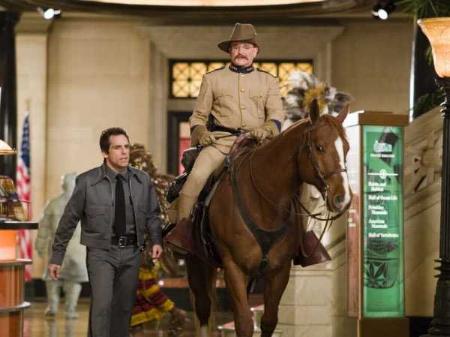
Well, be careful what you wish for. If there is an actor who has squandered more promise than Ben Stiller in making the transition to leading man, I'm not aware of that actor. I've sat in stunned silence through the smug sitcom bullshit of Meet the Parents and the laughless machinations of Envy and Duplex, cringed at his flaccid, forced turn in The Royal Tenenbaums and outright revolted at his cameo intensive association with Vince Vaughn and the Wilson brothers - I swear to God, if he ever again shows up with a wacky beard in some Will Ferrell flick, I'm setting this motherfucker on fire. I don't even know where I stand with Zoolander anymore - that one was funny, right? Right? Night at the Museum is particularly depressing because there's a distinct undercurrent of Robin Williams passing the torch to Ben Stiller: here you go son, you are now America's twitchy, manic goofball of choice for maudlin family comedies about the power of imagination and finding your inner child.
That's the story here: Ben Stiller's character is a hopeless dreamer who, as a last resort, takes a job as night watchman at the Natural History Museum in NYC. At night, the whole place comes alive, but he's such an unreliable dreamer that even his own son thinks he's crazy. His ex-wife is married to a douche-bag stockbroker (that's it, Paul Rudd: you're on the list. Watch it, pal), so his son wants to be a stock-broker and that depresses Stiller because he wants his son to play hockey. Or something. It doesn't seem like there's much of a conflict. Stiller's character is a loser - is the movie even disputing that? Anyway, once he gets the hang of dealing with a Bronze Columbus and a monosyllabic Easter Island statue, he teaches his son the true meaning of following your dreams. This also somehow helps him to seduce Carla Gugino. Incidentally, she's a non-factor. Just rent Judas Kiss (or Son in Law with Pauly Shore) instead if you were actually for some thick-skulled reason considering seeing this because of her. This movie is terrible. But it's making a boatload of money, so I guess the joke's on me and Ben Stiller gets to have the last laugh. Any guesses on the title for the inevitable sequel? Another Night at the Museum? Day at the Museum? The Day After Tomorrow at the Museum?
12.25.06. Christmas in Connecticut.
(tv, unedited and without commercials)
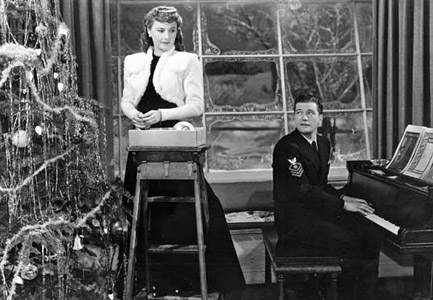
"Just use the ol' magoo." For some reason, my mom insisted that Preston Sturges directed this movie. I kept telling her that she was probably mixed up because Sturges directed a film called Christmas in July and also a couple movies with Barbara Stanwyck (the star of Christmas in Connecticut), but she wouldn't listen and I think we both watched this movie just out of spite to prove the other one wrong. Well, Preston Sturges did not direct this film, nor is Robert Preston the co-star with Stanwyck (my mom's bail-out excuse - why wouldn’t she accept my explanation?) and the movie itself is not so great. It's the story of a naval officer who survives a shipwreck and then develops a crush on author Stanwyck, whose sentimental articles on good house-keeping are his main company while stuck in convalescence. The articles make her seem like a dream-wife for an old-school military man, so he decides to look her up after his lengthy (and boring) recovery and use his "ol’ magoo" to get into her good graces.
Here's the catch: the articles are bullshit! Stanwyck is a progressive, saucy modern woman who sees the articles as a necessary evil for making a living as a writer. However, she can't resist the naval officer’s tantalizing magoo (or risk blowing her cover), so she arranges a fake weekend of sitcom-level proportions to make him think she’s really the woman her articles make her out to be. Of course, she doesn't really know how to take care of a cow or cook particularly well and the baby she borrows to complete the ruse ends up getting stolen, so the facade goes straight to shit in exactly the ways you'd imagine it would. Stanwyck is great (as always) and no movie with her as the star is without value and the whole production is attractive and the script serviceable and people like Gene Shalit and Richard Roeper love it, I'm sure... but this really is the type of movie you should only bother with if your mother insists you watch it on Christmas. And even then you'll probably only halfway bother to pay.
12.26.06.
Banff! No movie today as my family and I went to Banff, a gigantic Yellowstone-esque national park in the Canadian Rockies. We hiked around Lake Louise and it was ridiculously beautiful. A horse sneezed on me,* so at least something straight out of Preston Sturges happened.
* This is true. Also, it was so cold out, the horse-snot almost instantly froze on my jacket. I looked like I had fallen on a carton of eggs.
12.27.06. The Earrings of Madame de...
(dvd screener from Janus) on the train home from Calgary.
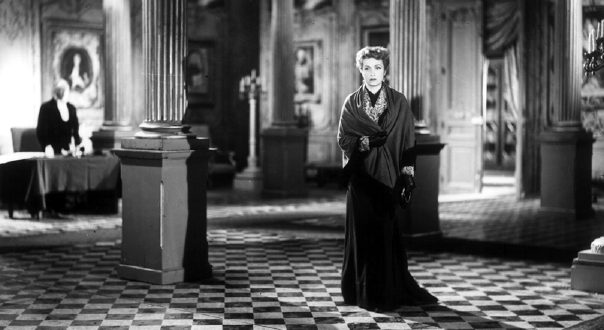
A tiny portable dvd-player screen probably isn't the best stage for director Max Ophul's ornate, balletic camera choreography. But Ophul's brand of contrivance-laden melodrama always plays better on the small screen, so maybe that balances everything out. Still, I couldn't help but feel like the setting in which I saw this movie was crippling its most remarkable aspect. The aforementioned camerawork really is a marvel of gliding, extended takes composed with an intricacy and intelligence that's beyond all but the most talented and ambitious of filmmakers. I'm not sure if the reduced effectiveness of the visual virtuosity is the reason, but the story itself left me cold. So the jury's still out on this one for me - I'm sure I'll be giving this film (or at least, Ophul's work in general) another chance in the near future, but for now I'm ambivalent at best. The novel on which the film is based was written in the 20th Century, but the whole thing has that distinct 18th flavor of despairing Countesses, mistaken identities, thwarted loves, jealous mistresses, tragic aristocrats, and plot contrivances. Anyway, I just wasn't in the mood for a guileless modern pastiche of such shenanigans. However, in its defense, I should mention that this film has a great tagline: "It was her vanity that destroyed her." That has the blunt force of a film noir teaser.
12.28.06. It's Impossible to Learn to Plow by Reading Books.
(dvd) on the train to Toronto from Calgary.
It's a weird experience to watch this film while taking a long train ride (such as the 58 hour train-ride from Calgary to New York which I am currently taking): Richard Linklater's first feature film (shot in 1989 on Super-8 film) is almost exclusively about the isolating experience of travel. As I watched minute after minute of landscape footage shot from the interior of a train; just to my left, mile after mile of actual frozen Canadian landscape passed by outside my real train. The experience mirrored my own to such a ridiculous and obvious extent that I'm not sure I have any real reaction to this film other than to say it is very, very accurate. Aside from the train trip on screen/train trip in real life mirroring, there was also the strange coincidence that two of the places Linklater's character visits in the film are places I myself have visited once. Now, before you say, "that's not much of a coincidence," let me point out that the locations in question are Missoula, Montana and Huntsville, Alabama - so, it's not like he went to Chicago and Los Angeles or something. All of that knocked me off balance - these type of unexpected connections rarely add up to much, but even the most level-headed rationalist can't help but be thrown off by them: I had the feeling of watching my own life unfold on-screen as it was happening: that is, I felt like I was sitting on train, watching myself sitting on a train, going to places I had been, the moments of the film replacing the moments of my life.
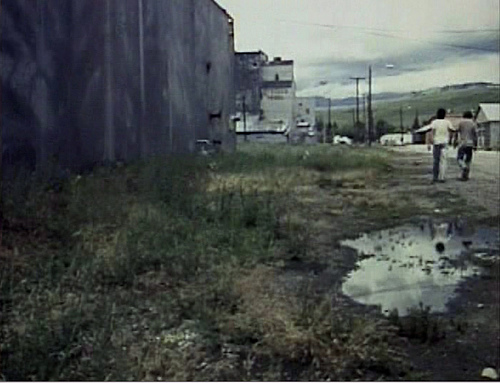
At any rate, a baby-faced Linklater stars in the film and, genuinely, there's not much to it. There's a little downtime before college starts back up again in the fall, so he leaves Austin to visit a friend in Missoula, takes the train up to Missoula, hangs out in Missoula a couple days, takes a bus to Portland (I think), takes a train down through San Francisco, gets back on the train, stops off in some other city in Texas to see his family, goes to Huntsville to take care of his mom's dogs, and then goes back to Austin. All of this happens in almost complete silence - which is probably the biggest shock of the film considering that Linklater is cinema's premiere conversationalist, the filmmaker who most astutely understands how ideas, people and the world reveal themselves through extended, meandering dialog. Travel has always been a secondary obsession of Linklater and here he's able to capture the rhythms of the tenuous loneliness inherent in a long trip - the fixed camera and subdued human interactions give you an intriguing picture of an alternate path of style that Linklater could've taken, but chose not to.
Essentially, the film consists of a repeating succession of three types of shots, all from a fixed camera position and generally only done in medium to very wide shots: Linklater entering/exiting frame, Linklater and one or two compatriots sitting in the middle of the frame, landscape shots taken from the interior of a moving vehicle. I don't think there is a single close-up in the entire film, save a strange cut-away focusing on a newspaper article concerning Sterling Hayden's death. This lack of close-ups has the (I would assume) intended effect of placing a complete emphasis on place: on the space that the characters are occupying. Anyway, since I'm on the train with hours to kill, I'm not really sure where I'm going with this - but I assure you this, the film captures the feeling of long distance travel with a melancholy precision. Though, I'm not sure if that only means that the film is a bit boring and depressing.
Other things to note about it: in the film, Linklater is pretty ripped and loves to walk around without his shirt on. He also is pretty fucking dynamite at basketball - witness him effortlessly sink three jumpers in a row. Guess those stories about him being groomed for professional sports (and subsequently derailed by injury) are true. There is a shocking moment at the end of the film (spoiler alert?) where Daniel Johnston meanders up to him on the streets of Austin, asks him what his shirt means (the Cyrillic words translate to the Russian saying "It's impossible to learn to plow by reading books") and the gives him a tape. The whole film is so loosely staged that it is utterly impossible to tell if this moment is planned or some amazing coincidence. In the next scene, Linklater listens to the tape and doesn't seem so impressed. Also, Daniel Johnston was not nearly so fat in 1989.
12.29.6 - 12.31.6.
If I watched any movies in this timeframe, I've certainly lost my notes for it. I know I watched about a half of an hour of Back to the Future Part II on New Year's Eve. But all I have to say about that movie is that, despite Ray Roy and Allen Cordell's insistence otherwise, it is truly an awful, nearly unwatchable film. And the hoverboards don't make up for anything.

<<click here for 1/1/7 - 1/10/7>>
home about contact us featured writings years in review film productions
All rights reserved The Pink Smoke © 2008